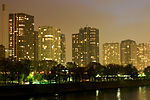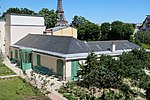Île aux Cygnes

Île aux Cygnes (French: [il o siɲ]; English: Isle of the Swans) is a small artificial island on the river Seine in Paris, France, in the 15th arrondissement. It was created in 1827 to protect the bridge named the pont de Grenelle. It should not be confused with an earlier Île des Cygnes that was attached to the Champ de Mars in the late 18th century. The uninhabited island is 850 metres (2,789 ft) long and 11 metres (36 ft) at its widest point, making it the third-largest island in Paris. A tree-lined walkway, named L'Allée des Cygnes (Path of Swans), runs the length of the island. Since 2012, there has been a public workout space with bicycles and a climbing wall underneath the Pont de Grenelle, close to a Statue of Liberty replica.The island is crossed by three bridges: the Pont de Grenelle, the Pont Rouelle and the Pont de Bir-Hakeim. It is served by the Passy and Bir-Hakeim Métro stations.
Excerpt from the Wikipedia article Île aux Cygnes (License: CC BY-SA 3.0, Authors, Images).Île aux Cygnes
Allée des Cygnes, Paris Quartier de Grenelle (Paris)
Geographical coordinates (GPS) Address Nearby Places Show on map
Geographical coordinates (GPS)
| Latitude | Longitude |
|---|---|
| N 48.852786111111 ° | E 2.2835972222222 ° |
Address
Allée des Cygnes
Allée des Cygnes
75015 Paris, Quartier de Grenelle (Paris)
Ile-de-France, France
Open on Google Maps









